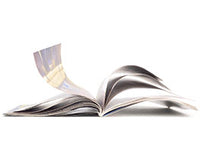One of the most frequent questions that arise when sending a file to print has to do with bleeds.
This word was (and perhaps still is) a real nightmare that could keep haunting if you don’t educate yourself.
-
What is a ‘bleed’
-
What is its purpose?
-
How do you calculate it?
-
What should be done to avoid bad surprises when receiving your printed product?
We will answer all these questions so you can ensure you provide print ready files that will look great in the finished product.
First step: Determining your printer’s requirements
Whichever printer (traditional or online) through which you are going to order your printing will always ask you to provide them with a file with bleed (bleeds, margins, etc.). An even better printer will provide free design templates online that will show you where the bleeds, margins, and fold lines are on the file. (Visit our downloadable templates here.)
These requirements can vary depending on the type of material and product, so it is always good to check on the specs determined by your printer.
If you are not a professional designer, perhaps you do not know the meaning of bleed(at least with regard to the world of printing), nor the reason why it is required to add this element in the file
Second Step: Explaining Bleeds
Explaining bleeds is very simple: Bleed is a printing term that is used to describe a document which has images or elements that touch the edge of the page, extending beyond the trim edge and leaving no white margin.
When a document has bleed, it must be printed on a larger sheet of paper and then trimmed down.
The minimum amount of bleed should be around 0.125" (3mm) outside your document final size, ideally 0.25" (6mm). Each printer has his own requirement for this. The only time you don't need to use bleed is when there is absolutely nothing printed on all sides (eg. a design with a white border.) In this case, you can simply provide your final print‐ready at its final size, without any extra bleed.
Some small ads in magazine or newspapers don't require it but it's better to provide a file with some bleed if you're not certain.
Another situation where you might not need to add bleed on all sides is when your file is provided as a “printer spread”; for example, a book cover design with the spine, front and back cover on the same layout OR a brochure with a fold OR a greeting card.
The bleed will only be necessary for the printer on the outside edges. It's still a good idea to create your own designs (front and back cover) with bleed on all sides; it will be easier for you to merge them together later when you'll prepare the final print‐ready file.
How the bleed is calculated?
As we have said before, each printer has different requirements depending on the type of machinery used, its margin of tolerance, and the type of item that has to be made. We advise to contact the printer directly to determine their exact requirements. If you plan to upload the work to an online printing service, these print bleed details are usually indicated on the website or at the time of completing the order.
Here, for example, you can see the available flyer formats and on each page, it is possible to download the graphics instructions of the item. If your art has a background, remember to extend it to the final margin of bleeding: this way you will avoid unwanted white edges around your design.
Safety Margins: Some Rules to
Keep in Mind
The reason why it is necessary to put a “safe margin” is very simple: as in the case of all work and mechanized treatment, even in the process of clipping typographical products may not be 100% accurate and generally the margin of error of the machine is a couple of millimeters on each side (for paper products, digital printing is something else). The bleed, therefore, serves to try to solve this problem and thus avoid printing errors. For the same reasons, you need to be careful and keep your texts or important elements within the “safe margin” of your design and nothing important should be on the “bleed” part! The safe margin should be 0.125" (3mm) inside your design. With books, some printers can even require up to 0.5" (13mm!)
Tips for Preparing your File
Now that you're familiar with bleeds and their calculation, here are some essential tips for preparing your design file correctly. First and foremost, consider the distance between texts or key design elements and the cut line, where the trimming to final size will occur.
To prevent these elements from being inadvertently trimmed, it's advisable to maintain a generous margin of approximately 0.25 inches from the bleed edge, which itself is 0.125 inches from the cutting line. This precaution ensures that your important content remains intact in the final print, accounting for the slight variations that can occur in the cutting machine (keep in mind these machines often cut multiple sheets at once, which can lead to minor deviations in the cut).
Regarding design frames: placing them too close to the cut line can lead to uneven trimming on different sides, resulting in an aesthetically displeasing outcome. Therefore, it's recommended to keep such frames at least 0.375 inches away from the margin. This way, even if the cutting machine isn't perfectly precise, the discrepancy will be less noticeable.





